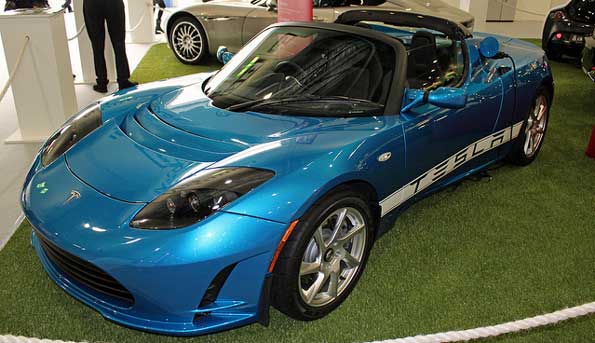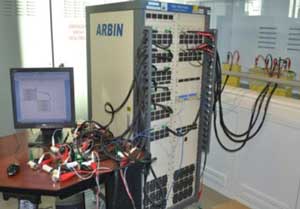Charging Ahead: The Future of Battery Technology
Batteries tend to stay in the background until we run into a problem — like a dead car battery stranding us in the middle of nowhere or a faulty cell phone battery tying us to an outlet. Despite this, many exciting, promising developments have recently stemmed from cutting-edge battery research.

The Tesla Roadster electric car. Image Credit: Trevor EV via flickr.
Technologies big and small have increased demand for more efficient batteries. Smaller gadgets, such as cell phones and tablets, require powerful batteries at the smallest size possible. Meanwhile, larger, more environmentally friendly vehicles require batteries that can compete with their internal combustion cousins. Creating batteries that can charge for a later use, power a device at the push of a button, recharge quickly and regularly, and be tailored to match the design and needs of different technologies requires a great deal of development work.
Scientists around the world are engaged in many different aspects of battery research, ranging from improving their durability and lifetime to optimizing them for integrating renewable energy systems (like solar and wind) into the electrical grid. There are groups working on new kinds of batteries that can store more charge for longer periods of time than the most efficient lithium-ion batteries, and other groups are working on techniques for charging batteries more rapidly. As hybrid and fully electric vehicles become increasingly popular, research related to optimizing electric vehicle battery technology has already taken off.
How Much Juice is Left?
Particularly important for electric vehicles is the ability to accurately predict how much charge is left in a battery at any given time, also known as its state-of-charge. In most automobiles, fuel gauges monitor the amount of gas remaining in the tank and drivers know to fill up when the gauge approaches empty. Similarly, in an electric vehicle, a state-of-charge monitor plays the role of a fuel gauge and lets the driver know how much charge is left in the battery. No one wants to be stranded miles away from a charging station, so researchers attempt to ensure the most accurate state-of-charge readings in electric vehicles.
A research team from North Carolina State University led by Dr. Mo-Yuen Chow and his PhD student Habiballah Rahimi-Eichi recently devised a system to more reliably determine the amount of charge remaining in a lithium-ion battery, like those used in plug-in electric cars. You may have noticed that battery monitors, like those on cell phones, tend to become less reliable as the battery ages.

The battery testing system used by the NCSU team. Image Credit: Habiballah Rahimi-Eichi/Mo-Yuen Chow/NCSU
That's because a battery's ability to hold charge depends on several factors that vary with time — the age of the battery, its temperature, and the rate at which the battery was charged, for example. Most battery monitoring systems do not take all of these factors into account; instead, they rely on measurements of the battery's voltage or current, which are not always very accurate predictors of what is happening in a battery.
A battery's state-of-charge cannot be directly measured, so researchers have been developing models that predict state-of-charge using a number of input variables. Unlike other models, Chow and Rahimi-Eichi's model relies on software that incorporates data from a battery's voltage and current readings, in addition to its charging/discharging rate, age, and temperature in real time and feeds them into a program that predicts the state-of-charge. The team's model yields a prediction that is accurate to within 5 percent, and it is easier to implement than similarly accurate models.
Better Detection, Faster Charging
A group at the University of California San Diego is also working to improve battery charging, with the ultimate goal of designing batteries and charging systems for electric vehicles that are based on a better understanding of what physically happens inside of a lithium-ion battery over time. A team of engineers led by Miroslav Krstic and Scott Moura recently created a sophisticated mathematical model of the location of the lithium ions within a battery as it charges and discharges.
Knowing how the ions are distributed in a battery over time could open the door for researchers to find the optimal rates for charging and discharging batteries. Consequently, they could design lighter batteries that charge faster. Usual methods of monitoring batteries, such as measuring current and voltage, are less accurate and can lead to batteries that are overbuilt and oversized for the job. However, the team of engineers estimate that this new technique could reduce the cost of lithium-ion batteries by as much as 25 percent and enable them to charge in as little as half of the time.
Both of these models require additional testing in real word situations to see how they compare to existing techniques, but they are important steps toward making electric vehicles more appealing to drivers who are used to refueling quickly when the tank is getting low. They are also likely to be useful for applications beyond electric vehicles — and could form the basis for better battery monitoring and recharging systems in future generations of battery powered devices.
More Information and Resources
- HowStuffWorks: How Lithium-ion Batteries Work
Explore the inside of a lithium-ion battery without taking one apart (which is very dangerous, so don't do it!). - North Carolina State University: Researchers Develop New Way to
Determine Amount of Charge Remaining in Battery
Read more about the battery monitoring model created by Chow and Rahimi-Eichi. This article also links to a copy of their technical paper describing the model. - USCD Jacobs School of Engineering: New Sophisticated Control Algorithms
Poised to Revolutionize Electric Battery Technology
Read more about the mathematical model created by Krstic and Moura and how it could led to cheaper, more optimal batteries. - Battery University: How to Measure State-of-Charge
Learn about the methods commonly used to measure a battery's state-of-charge. - PhysicsCentral: Wirelessly Charged Electric Buses
Read about a new bus route that will feature electric buses that wirelessly charge while waiting for passengers.
—Kendra Redmond














